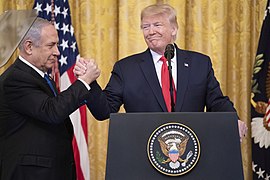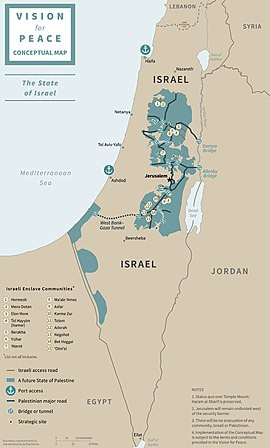
Back صفقة القرن Arabic Трампил ракълил план AV План ЗША па блізкаўсходнім урэгуляванні Byelorussian ট্রাম্পের শান্তি পরিকল্পনা Bengali/Bangla Pla de pau de Trump Catalan Peace to Prosperity: A Vision to Improve the Lives of the Palestinian and Israeli People Danish Ειρηνευτικό σχέδιο Τραμπ Greek Traktato de la Jarcento Esperanto Plan de paz de Trump Spanish معامله قرن Persian
| Part of a series on the Israeli–Palestinian conflict |
| Israeli–Palestinian peace process |
|---|
The Trump peace plan, officially titled "Peace to Prosperity: A Vision to Improve the Lives of the Palestinian and Israeli People", was a proposal by the first Trump administration to resolve the Israeli–Palestinian conflict. President Donald Trump formally unveiled the plan in a White House press conference alongside Israeli Prime Minister Benjamin Netanyahu on 28 January 2020. The plan had been delayed by two years and previously rejected by the Palestinians, who were not invited to the meeting.[1]
The plan was authored by a team led by Trump's son-in-law and senior advisor Jared Kushner.[2] Both the West Bank settlers' Yesha Council[3] and the Palestinian leadership rejected the plan, the former because it envisaged a Palestinian state,[3] and the latter arguing that it was too biased in favor of Israel.[1] The plan was divided into two parts, an economic portion and a political portion. On 22 June 2019, the Trump administration released the economic portion of the plan, titled "Peace to Prosperity". The political portion was released in late January 2020.[1]
The plan had been characterized as requiring too few concessions from the Israelis and imposing too harsh requirements on the Palestinians. Reactions among congressional Democrats were mixed, and all the leading Democratic 2020 presidential candidates[4] denounced it as a "smokescreen" for annexation.[5][6] Proposed benefits to the Palestinians from the plan are contingent on Israel and the United States subsequently agreeing that a list of conditions have been implemented, including total demilitarization, abandonment of international legal action against Israel and the United States and compliance "with all the other terms and conditions" of the 180-page plan. Many of these conditions have been denounced by opponents of the plan as "impossible" or "fantastic."[7][8][9] The plan proposed a series of Palestinian enclaves surrounded by an enlarged Israel, and rejected a Palestinian capital in East Jerusalem proper, proposing instead a Palestinian capital on the outskirts of the city. The proposed areas for the Palestinian capital have been described as "grim neighborhoods" and are separated from Jerusalem proper by the Israeli West Bank barrier.[10][11] Many Israeli settlers have expressed discontent and concern with the plan's security assurances.[10][12][13][14]
During the press conference announcing the plan, Netanyahu announced that the Israeli government would immediately annex the Jordan Valley and West Bank settlements while committing not to create new settlements in areas left to the Palestinians for at least four years. U.S. Ambassador to Israel David M. Friedman claimed that the Trump administration had given permission for an immediate annexation, stating that "Israel does not have to wait at all" and "we will recognize it".[15] A spokesman for the Israeli governing Likud party tweeted that Israeli sovereignty over settlements would be declared on the following Sunday. The Trump administration clarified that no such green light for annexation had been given;[16] Trump later explained that "I got angry and I stopped it because that was really going too far".[17]
- ^ a b c "Trump reveals Israeli-Palestinian peace plan". Deutsche Welle. January 28, 2020. Archived from the original on January 29, 2020. Retrieved January 29, 2020.
- ^ "Trump releases long-awaited Middle-East peace plan". BBC News. January 28, 2020. Archived from the original on January 28, 2020. Retrieved January 28, 2020.
- ^ a b Magid, Jacob (January 28, 2020). "Settler leaders call on PM to oppose Trump plan, even at the cost of annexation". The Times of Israel. Archived from the original on January 29, 2020. Retrieved January 29, 2020.
- ^ "Democratic candidates censure Trump peace plan, warn against annexation". The Times of Israel. January 28, 2020. Archived from the original on January 29, 2020. Retrieved January 29, 2020.
Biden: "This is a political stunt that could spark unilateral moves to annex territory; Warren: "Trump's 'peace plan' is a rubber stamp for annexation"; Buttigieg: "Peace requires both parties at the table. Not a political green light to the leader of one for unilateral annexation.
- ^ "Opinion: Trump's Israel-Palestine 'deal' has always been a fraud". Financial Times. January 28, 2020. Archived from the original on January 29, 2020. Retrieved January 29, 2020.
It always looked like a smokescreen to mask the burial of the two-state solution — an independent Palestinian state on the occupied West Bank, and Gaza with Arab East Jerusalem as its capital living in peace alongside Israel — and greenlight the Israeli annexation of most of the West Bank.
- ^ J Street, "It's Not a Peace Plan, It's an Annexation Smokescreen", "If there was ever any doubt that the Trump-Netanyahu 'peace plan' was anything other than a smokescreen for annexation, it was disabused just moments after the plan's glitzy White House announcement."
- ^ Lee, Matthew; Heller, Aron (January 29, 2020). "Trump peace plan delights Israelis, enrages Palestinians". Associated Press. Archived from the original on January 29, 2020. Retrieved January 29, 2020.
It sides with Israel on key contentious issues that have bedeviled past peace efforts, including borders and the status of Jerusalem and Jewish settlements, and attaches nearly impossible conditions for granting the Palestinians their hoped-for state
- ^ Cite error: The named reference
WPwas invoked but never defined (see the help page). - ^ Bar'el, Zvi (February 1, 2020). "Analysis Trump's Plan Embraces the Jewish Biblical Narrative. History Is Only Getting in the Way". Ha'aretz. Retrieved February 8, 2020.
Among other conditions, the Palestinians must have... "complied with all the other terms and conditions of this Vision."... Palestine, which was recognized by the UN General Assembly in 2012 as a non-member state with observer status in the organization, would have trouble meeting Trump's conditions. These conditions are supposedly meant to ensure that Palestine will be a law-abiding state that protects human rights and meets the criteria of international financial institutions. But Trump also appointed an Israeli-American supervisory body – rather than an international body or international conventions – to determine whether these conditions are met. This innovation ought to shock the United Nations, but so far, it has not been dumbstruck. No Middle Eastern state, including Iraq, which America occupied, has been asked to satisfy such criteria as a condition for recognition or for diplomatic relations with America... But even if the PA and Hamas miraculously reached agreements on disarmament or school curricula, would Israel let election be held in the Palestinian enclaves remaining under its control? This sort of election might well produce a Hamas government ruling the entire territories, or at least a national unity government with Hamas as its senior partner. But Trump's plan explicitly says that Palestine's government cannot include "any members" of Hamas, Islamic Jihad "or surrogates thereof" unless all the listed conditions for their participation have been met – namely, that "Gaza is fully demilitarized," and that "the Palestinian Authority or another national or international body acceptable to the State of Israel is in full control of Gaza," and that Hamas, Islamic Jihad "and all other militias and terror organizations in Gaza are disarmed." If these conditions aren't met, Israel won't have to fulfill its obligations under the Israeli-Palestinian peace treaty. Consequently, establishing a Palestinian state will be like wandering through a maze that has no exits. Every path the PA might try will be blocked by a series of conditions whose fulfillment will have to be certified by Israel.
- ^ a b Kershner, Isabel (February 27, 2020). "Trump's Plan Backs Israeli Settlements. So Why Are Settlers Unhappy?". The New York Times. ISSN 0362-4331. Retrieved March 3, 2020.
- ^ Kershner, Isabel; Halbfinger, David M. (January 31, 2020). "Capital in Trump Mideast Plan Makes 'a Joke' of Palestinian Aspirations". The New York Times. ISSN 0362-4331. Retrieved March 22, 2020.
- ^ Homan, Timothy R. (January 28, 2020). "Democrats offer mixed reactions to Trump's Mideast peace plan". TheHill. Retrieved March 3, 2020.
- ^ "I've been an Israeli settler for 30 years. Trump's peace plan puts our communities in danger". Jewish Telegraphic Agency. February 3, 2020. Retrieved March 22, 2020.
- ^ Magid, Jacob. "Settler leaders call on PM to oppose Trump plan, even at the cost of annexation". www.timesofisrael.com. Archived from the original on January 29, 2020. Retrieved March 22, 2020.
- ^ "Ambassador Friedman: Israel 'does not have to wait' to annex settlements". JNS.org. January 28, 2020. Retrieved March 22, 2020.
- ^ Yossi Verter, "How Trump's "Deal of the Century' Became the Joke of the Century" Archived February 1, 2020, at the Wayback Machine Haaretz January 31, 2020
- ^ Barak Ravid, Dec 13, 2021 Trump says Netanyahu "never wanted peace" with the Palestinians, Axios



